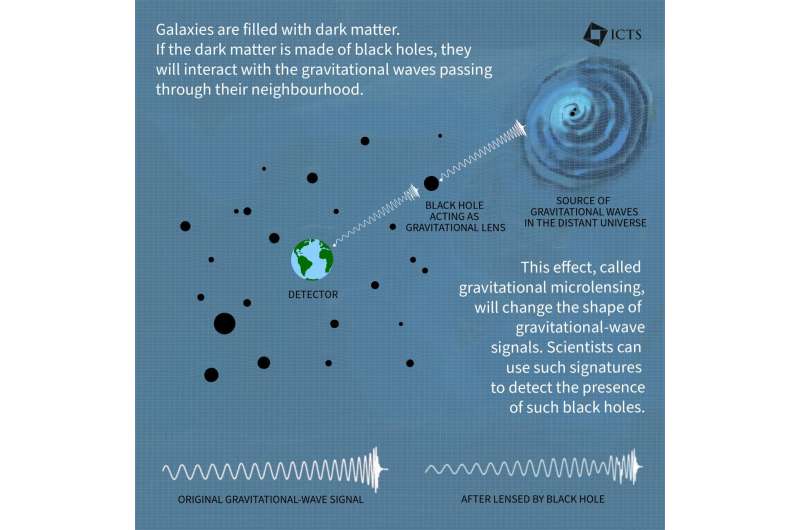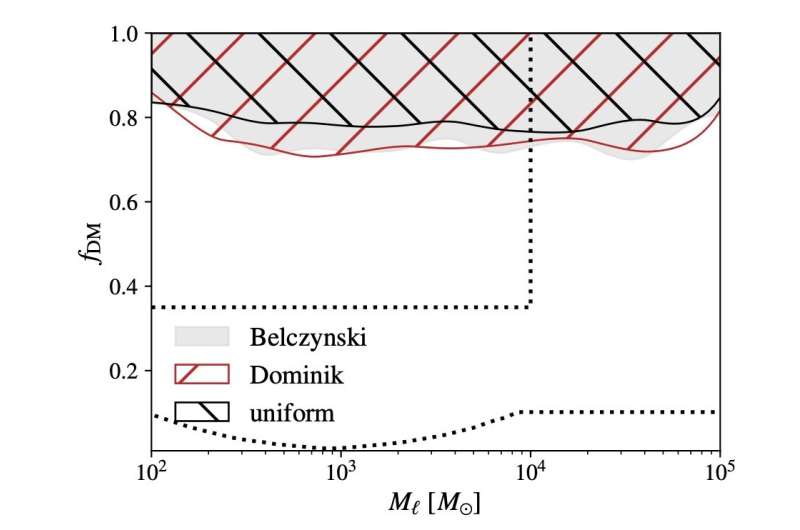Astrophysicists set constraints on compact dark matter from gravitational wave

The existence of dark matter remains one of the greatest mysteries of the universe. While studies have indirectly hinted at its existence, its invisible nature makes this elusive substance very difficult to detect, thus its composition remains unknown.
Dark matter could be made of fundamental and exotic particles that are yet to be discovered. Alternatively, it could consist of many massive and compact objects, such as primordial black holes (i.e., black holes formed in the early universe).
Over the past decades, many teams of scientists worldwide have been searching for dark matter, using a multitude of techniques, telescopes, detectors and observational data. While most of these searches were unsuccessful, they helped to guide and narrow down subsequent searches.
Researchers at Tata Institute of Fundamental Research’s International Centre for Theoretical Studies in Bangalore, India, have recently set new constraints on the fraction of compact dark matter from gravitational wave microlensing. Their paper, published in The Astrophysical Journal Letters, introduces a new way of probing the nature of dark matter by looking for microlensing effects in gravitational waves.
“According to Einstein’s theory of general relativity, massive objects bend light as normal optical lenses do,” Parameswaran Ajith, one of the researchers who carried out the study, told Phys.org. “Massive objects, such as black holes that lie in between the astronomical source and the observer, can magnify the source. This phenomenon, called gravitational microlensing, has emerged to be a powerful tool for astronomers.”
Despite the extensive research efforts in the field, astronomers have so far been unable to observe the microlensing effects produced by black holes. This suggests that black holes that are much lighter than the sun, which would produce the microlensing of light, are rare.
“Even if these black holes exist, they are likely to constitute only a very small fraction of the dark matter,” Ajith said. “Theory predicts that gravitational waves will also be lensed in the same way. If primordial black holes that are much more massive than the sun are abundant in the universe, they will distort the gravitational waves.”
 Upper limits on the fraction of dark matter in the form of compact objects obtained by this study. The mass of the black hole is shown on the horizontal axis. Three different exclusion regions correspond to three assumed models of the distribution of binary black holes in the universe. The dashed lines show some of the existing constraints from the microlensing of supernovae (SN) and from the stability of wide binaries (WB). Credit: The Astrophysical Journal Letters (2022). DOI: 10.3847/2041-8213/ac4dfa
Upper limits on the fraction of dark matter in the form of compact objects obtained by this study. The mass of the black hole is shown on the horizontal axis. Three different exclusion regions correspond to three assumed models of the distribution of binary black holes in the universe. The dashed lines show some of the existing constraints from the microlensing of supernovae (SN) and from the stability of wide binaries (WB). Credit: The Astrophysical Journal Letters (2022). DOI: 10.3847/2041-8213/ac4dfaIn 2003, some theoretical physicists accurately calculated the nature of gravitational wave distortions. Almost two decades later, Sunghoon Jung and Chang Sub Shin, two scientists at Seoul National University and the IBS Center for Theoretical Physics of the Universe suggested that the non-observation of these distortions by the LIGO and Virgo collaborations could help to constrain the abundance of black holes that are significantly more massive than the sun.
The recent paper by Ajith and his colleagues draws inspiration from these previous works. The team’s work is based on the assumption that if a significant fraction of dark matter were actually comprised of compact objects, these objects would cause microlensing effects in the gravitational wave signals periodically detected by the LIGO and Virgo detectors.
“Back in 2018, in collaboration with colleagues in the LIGO-Virgo Collaboration, we had searched for signatures of such distortions in the gravitational-wave signals observed by LIGO and Virgo and found none,” Ajith said. “However, since LIGO and Virgo had observed only 10 gravitational-wave signals by then, our prior expectation for finding such distortions was low.”
Recently LIGO-Virgo Collaboration announced similar null results from its third observing run. “In addition, Ajith and his colleagues independently analyzed the gravitational waves that a group at the Institute for Advanced Studies (IAS) in Princeton had uncovered within the LIGO-Virgo data. Overall, they thus analyzed more than 50 gravitational wave events.
While the researchers were unable to observe microlensing distortions in any of the signals they analyzed, their analyses allowed them to set further constraints on compact dark matter. In other words, they constrained the fraction of dark matter that consists of massive black holes.
“The constraints that we obtained so far are quite modest,” Ajith said. “All we can say is that not more than 50% of the dark matter is in the form of massive black holes, which is not new information. However, in the next few years, LIGO and Virgo are expected to observe hundreds to thousands of gravitational-wave signals. These observations will allow us to improve these constraints significantly.”
In the future, Ajith and his colleagues plan to analyze all new gravitational wave events recorded by the LIGO-Virgo detectors. In addition, they hope that their recent work will encourage other teams to use the microlensing of gravitational waves to investigate the nature of dark matter.
“As part of the LIGO-Virgo Collaboration, we are analyzing all the gravitational wave signals detected by LIGO and Virgo during their past three observing runs (a total of close to 100 events),” Ajith added. “This will improve the constraint a little bit. However, we are looking forward to analyzing data from the next observing run, where LIGO and Virgo are expected to observe hundreds of gravitational-wave signals!”
S. Basak et al, Constraints on Compact Dark Matter from Gravitational Wave Microlensing, The Astrophysical Journal Letters (2022). DOI: 10.3847/2041-8213/ac4dfa
© 2022 Science X Network
Citation:
Astrophysicists set constraints on compact dark matter from gravitational wave microlensing (2022, April 1)
retrieved 1 April 2022
from https://phys.org/news/2022-04-astrophysicists-constraints-compact-dark-gravitational.html
This document is subject to copyright. Apart from any fair dealing for the purpose of private study or research, no
part may be reproduced without the written permission. The content is provided for information purposes only.
Read More: Astrophysicists set constraints on compact dark matter from gravitational wave

